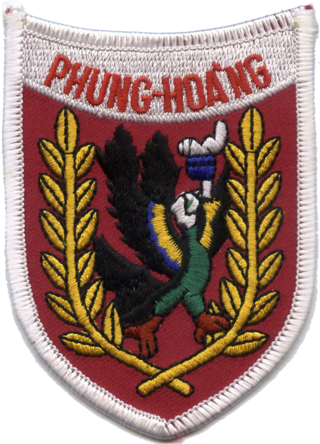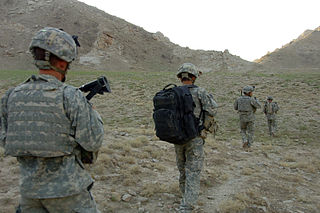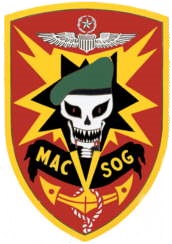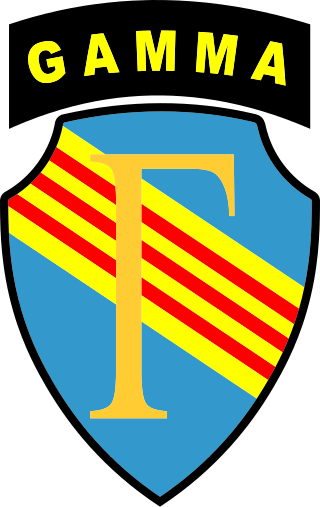Related Research Articles

The United States Navy Sea, Air, and Land (SEAL) Teams, commonly known as Navy SEALs, are the United States Navy's primary special operations force and a component of the United States Naval Special Warfare Command. Among the SEALs' main functions are conducting small-unit special operation missions in maritime, jungle, urban, arctic, mountainous, and desert environments. SEALs are typically ordered to capture or kill high-level targets, or to gather intelligence behind enemy lines. SEAL team personnel are hand-selected, highly trained, and possess a high degree of proficiency in unconventional warfare (UW), direct action (DA), and special reconnaissance (SR), among other tasks like sabotage, demolition, intelligence gathering, and hydrographic reconnaissance, training, and advising friendly militaries or other forces. All active SEALs are members of the U.S. Navy.

The United States Army Special Forces (SF), colloquially known as the "Green Berets" due to their distinctive service headgear, is the special operations branch of the United States Army. Although technically an Army branch, the Special Forces operates similarly to a functional area (FA), in that individuals may not join its ranks until having served in another Army branch.

Force Reconnaissance (FORECON) are United States Marine Corps reconnaissance units that provide amphibious reconnaissance, deep ground reconnaissance, surveillance, battle-space shaping and limited scale raids in support of a Marine Expeditionary Force (MEF), other Marine air-ground task forces or a joint force. Although FORECON companies are conventional forces they share many of the same tactics, techniques, procedures and equipment of special operations forces. During large-scale operations, Force Reconnaissance companies report to the Marine Expeditionary Force (MEF) and provide direct action and deep reconnaissance. Though commonly misunderstood to refer to reconnaissance-in-force, the name "Force" Recon refers to the unit's relationship with the Marine Expeditionary Force or Marine Air-Ground Task Force. Force reconnaissance platoons formed the core composition of the initial creation of the Marine Special Operations Teams (MSOTs) found in Marine Forces Special Operations Command (MARSOC) Raider battalions, though Marine Raiders now have their own separate and direct training pipeline.

A long-range reconnaissance patrol, or LRRP, is a small, well-armed reconnaissance team that patrols deep into enemy-held territory.

The Phoenix Program was designed and initially coordinated by the United States Central Intelligence Agency (CIA) during the Vietnam War, involving the American, South Vietnamese militaries, and a small amount of special forces operatives from the Australian Army Training Team Vietnam. In 1970, CIA responsibility was phased out, and the program was put under the authority of the Civil Operations and Revolutionary Development Support (CORDS).

The United States Naval Special Warfare Command (USNSWC), also known as NAVSPECWARCOM and WARCOM, is the naval component of United States Special Operations Command, the unified command that oversees and conducts the nation's special operations and missions.

Long-range surveillance (LRS) teams were elite, specially-trained surveillance units of the United States Army employed for clandestine operation by Military Intelligence for gathering direct human intelligence information deep within enemy territory. Classic LRS employment is to infiltrate deep into enemy territory, construct hide and surveillance sites, and provide continuous surveillance/special reconnaissance of an intelligence target of key interest.

Military Assistance Command, Vietnam – Studies and Observations Group (MACV-SOG) was a highly classified, multi-service United States special operations unit which conducted covert unconventional warfare operations before and during the Vietnam War.

Tan Son Nhut Air Base (1955–1975) was a Republic of Vietnam Air Force (RVNAF) facility. It was located near the city of Saigon in southern Vietnam. The United States used it as a major base during the Vietnam War (1959–1975), stationing Army, Air Force, Navy, and Marine units there. Following the Fall of Saigon, it was taken over as a Vietnam People's Air Force (VPAF) facility and remains in use today.

The Army of the Republic of Vietnam Special Forces (Vietnamese: Lực Lượng Đặc Biệt Quân Lực Việt Nam Cộng Hòa, or LLDB were the elite military units of the Army of the Republic of Vietnam. Following the establishment of the Republic of Vietnam in October 1955, the Special Forces were formed at Nha Trang in February 1956. During the rule of Ngô Đình Diệm, the Special Forces were run by his brother, Ngô Đình Nhu, until both were assassinated in November 1963 in a coup. The Special Forces were disbanded in 1975 when South Vietnam ceased to exist after the Fall of Saigon.

The Mobile Strike Force Command, or MIKE Force, was a key component of United States Army Special Forces in the Vietnam War. They served with indigenous soldiers selected and trained through the largely minority Civilian Irregular Defense Group (CIDG) and were led by American Special Forces and Australian Army Training Team Vietnam (AATTV) personnel. MIKE Force was a force multiplier, operating what is today called a foreign internal defense mission.

Special reconnaissance (SR) is conducted by small units, such as a recon team, made up of highly trained military personnel, usually from special forces units and/or military intelligence organizations. Special reconnaissance teams operate behind enemy lines, avoiding direct combat and detection by the enemy. As a role, SR is distinct from commando operations, but both are often carried out by the same units. The SR role frequently includes covert direction of airstrikes and indirect fire, in areas deep behind enemy lines, placement of remotely monitored sensors, and preparations for other special forces. Like other special forces, SR units may also carry out direct action and unconventional warfare, including guerrilla operations.
Project DELTA was the first of the Reconnaissance Projects, which were special reconnaissance (SR) units named with a Greek letter. The Reconnaissance Projects were formed by the U.S. Military Assistance Command, Vietnam (MACV) during the Vietnam War to collect operational intelligence in remote areas of South Vietnam.

Project GAMMA was the name given in 1968 to Detachment B-57, Company E, 5th Special Forces Group (Airborne) in Vietnam from 1967 to 1970. It was responsible for covert intelligence collection operations in Cambodia. The teams were highly effective at locating Viet Cong operations in Cambodia, leading to their destruction. When assets began to disappear, they identified a South Vietnamese officer as the mole. On the advice of the CIA, they took extrajudicial steps and murdered him. Seven officers and one non-commissioned officer were arrested and tried. When the CIA refused to answer summons for witnesses for national security reasons, the charges were dropped.

Special forces or special operations forces (SOF) are military units trained to conduct special operations. NATO has defined special operations as "military activities conducted by specially designated, organized, selected, trained and equipped forces using unconventional techniques and modes of employment".

Operation Toan Thang I was a U.S. Army, Army of the Republic of Vietnam (ARVN), 1st Australian Task Force and Royal Thai Volunteer Regiment operation conducted between 8 April and 31 May 1968 in the Vietnam War. The operation was part of a reaction to the Tet Offensive designed to put pressure on Vietcong (VC) and People's Army of Vietnam (PAVN) forces involving the South Vietnamese III Corps.

Operation Truong Cong Dinh, was a United States and Army of the Republic of Vietnam (ARVN) security operation to reestablish South Vietnamese control over the northern Mekong Delta in the aftermath of the Tet Offensive. The operation aimed to root out Viet Cong (VC) forces in the area, and to stop them from attacking traffic on the nearby Highway 4.

The U.S. Army Special Forces traces its roots as the Army's premier proponent of unconventional warfare from purpose-formed special operations units like the Alamo Scouts, Philippine guerrillas, First Special Service Force, and the Operational Groups (OGs) of the Office of Strategic Services. Although the OSS was not an Army organization, many Army personnel were assigned to the OSS and later used their experiences to influence the forming of Special Forces.
Operation Washington Green was a security and pacification operation during the Vietnam War conducted by the 173rd Airborne Brigade in Bình Định Province from 15 April 1969 to 1 January 1971.
References
- ↑ U.S. Army Special Forces 1961-1971. United States Army Center of Military History. 1989. CMH Pub 90-23. Archived from the original on 2014-02-12. Retrieved 2010-08-19.
- ↑ Hawkins, Tony (31 October 2008). "USASOC honors clandestine SF unit from Vietnam War". Army.mil. Archived from the original on 24 March 2022. Retrieved 22 July 2022.
- Stanton, Shelby, Vietnam Order of Battle, ISBN 0-89193-700-5
- Sorley, Lewis, A Better War: The Unexamined Victories and Final Tragedy of America's Last Years in Vietnam, ISBN 0-15-601309-6